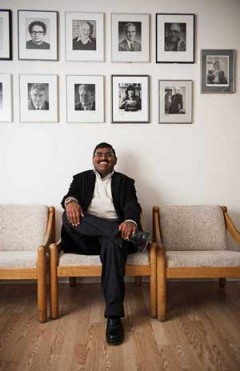Chinnaiah Jangam Discusses M. Nagloo, India’s first Dalit hotelier

As part of the Dalit History Month 2021 series, History Professor Chinnaiah Jangam has written an article discussing the historical significance of M. Nagloo and the English biography his son would go on to write about him. A short excerpt of Professor Jangam’s article, “Meet M. Nagloo, India’s first Dalit hotelier who was famous among British, US travellers,” in The Print is included below. The full article is available online.
During my doctoral research, I was advised by my research supervisor Peter Robb to read catalogues. I used to diligently pick up catalogues in the India Office section of the British Library. Once, I landed on a biography of M. Nagloo, the first written-about Dalit hotelier. I was astonished to see a Dalit biography written as early as 1908 and that too in English. The biography, Maidara Nagayya, written by Nagloo’s son M.N. Venkataswami, opened all-new vistas about the unusual rise of a Dalit and the historical account of the early colonial encounters and British rule’s stabilisation in the Central Provinces.
Another significant aspect of this biography is that it was written twice in two different versions. Venkataswami first wrote and published a hundred copies of the biography in 1908. He had sent 57 copies to his father’s well-wishers and friends in England and the United States. Unfortunately, the remainder of 43 copies were swept away in the floods of 1908 in Hyderabad. Venkataswami rewrote the biography and published it in 1929 with extensive corrections and additions. Interestingly, but not surprisingly, both the versions of the biography ended up in the British Library.
This biography is not only rare, but is perhaps the first Dalit biography written in English. It challenges conventional historical understanding in Dalit studies, which presumes that before Ambedkar, there were no significant scholarly articulations and writings by Dalits. In contrast, the author of this biography, M.N. Venkataswami, was a prolific writer in English. He was a Royal Asiatic Society member and a well-established folklorist of his time. He consistently published in international journals like Folklore and Indian Antiquity. He translated Valmiki’s Ramayana in English with Ralph T.H. Griffith. He wrote The Story of Bobbili: As Handed Down Through Minstrels with Jadhunath Sarkar in 1912, and with Narayan G. Chandavarkar wrote Folk Stories of the Land of Ind in 1927. He worked as a librarian at the State Central Library in Hyderabad.
Most importantly, Venkataswami’s acquaintance with the larger academic world is too impressive and difficult to ignore. In her recent book The Audacious Raconteur (Cornell University Press, 2020), Leela Prasad has a chapter devoted to Venkatswami titled ‘Sovereignty and Storytelling Colonial India’, which describes his folkloric contributions. Meanwhile, I am trying to trace the family both in Nagpur and Hyderabad, and so far have made multiple trips in vain. I will edit and publish the biography soon.